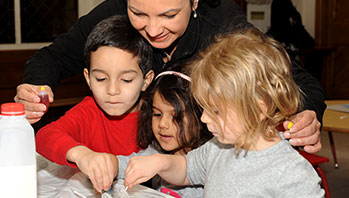- balls
- toilet paper tubes
- ramp
- steep
- steeper
MA Standards:
English Language Arts/Language/L.PK.MA.6: Use words and phrases acquired through conversations, listening to books read aloud, activities, and play.
MA Draft Standards:
Physical Sciences/Motion and Stability; Forces and Interaction/PS2.A: Plan and carry out investigations of the behaviors of moving things.
Physical Sciences/Motion and Stability; Forces and Interaction /PS2.B: Using evidence, discuss ideas about what is making something move the way it does and how some movements can be controlled. [Cause and Effect, Stability and Change]
Head Start Outcomes:
Logic and Reasoning/Reasoning and Problem Solving: Recognizes cause and effect relationships.
Science Knowledge/Scientific Skills and Method: Uses senses and tools, including technology, to gather information, investigate materials, and observe processes and relationships.
PreK Learning Guidelines:
English Language Arts/Language 2: Participate actively in discussions, listen to the ideas of others, and ask and answer relevant questions.
Small Group: Body Ramps

© Commonwealth of Massachusetts, Department of Early Education and Care (Jennifer Waddell photographer). All rights reserved.
STEM Key Concepts: A ramp is a surface with one end higher than the other; An object placed on an inclined plane will roll, slide, or stay put; Rolling and sliding objects move faster down a steeper incline
ELA Focus Skills: Gross Motor Skills, Speaking and Listening, Vocabulary
Tell children they are going to explore making new kinds of ramps. Explain that these ramps won’t be made with materials because they will be making body ramps!
Discuss different parts of the body that can be used as a ramp. Explain that children will use these different parts of their bodies to roll and slide objects down.
- Model how to make your leg into a ramp (either from your knees to your feet, or the entire length of your legs).
- Invite a volunteer to place a toilet paper tube at the top of your “ramp” and let it roll down.
Divide children into small groups to build their own body ramps and to take turns sliding objects down their bodies.
- Encourage children to think of as many ways to use their bodies as they can, for example, arms, hands, or backs. Encourage children to make steep and steeper ramps within the group.
- Visit the groups and take photos, encouraging children to talk about or draw to document their explorations.
